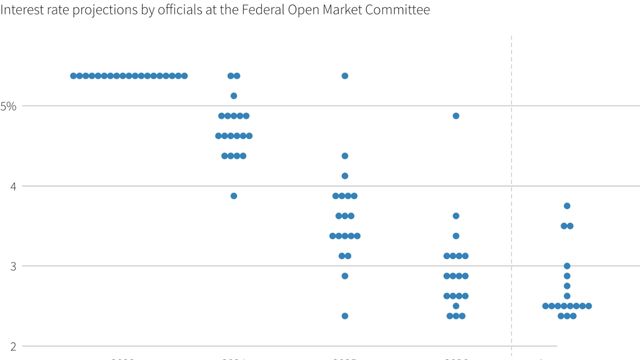Wednesday, the Federal Reserve kept interest rates the same. Jerome Powell, the head of the U.S. central bank, said that the record tightening of monetary policy is likely over because inflation is falling faster than expected and talks about lowering interest rates are “coming into view.”
Fed Chair Jerome Powell told reporters after the end of the last policy meeting of the year, “People are not writing down rate hikes” in their most recent economic forecasts.
He said, “That’s us thinking we’ve done enough.” He also said that rate hikes were “not the base case anymore.”
Diane Swonk, chief economist at KPMG US, said, “The Fed is done!” If economic data keeps changing the way it has, with inflation falling and an economy that looks like it will slow down but not crash, then “the Fed will be cutting sooner” rather than later this year.
In fact, there was a big change in the view. Out of 19 Fed policymakers, 17 thought rates would go down by the end of 2024, while none thought they would go up. A measure of how policymakers see the risks to the economy also got closer to balance. Powell hinted at this when he said that the central bank was now at a point where “both mandates are important,” with officials aware of the risk of “overdoing it” and slowing the economy down faster than needed.
By law, the Federal Reserve is supposed to keep prices stable and jobs at a high level. However, these are two economic goals that don’t always agree with each other. Last year, inflation hit its highest level in 40 years. Powell said that officials thought they were getting closer to a “soft landing,” which would mean that inflation would return to the Fed’s target level of 2% in an economy that is slowing but not collapsing and where unemployment stays low.

“We’re seeing strong growth that… seems to be slowing down.” There are signs that the job market is getting back to normal… Powell told the media, “We’re seeing prices rise really quickly.” “These are the things we’ve been looking forward to… It would be too soon to declare success… The real question, though, is “when will it be right to start dialing back?”
This is a debate that the Federal Reserve and investors will be thinking about for the next few weeks and months. This comes after the Fed cut back on the asset purchases it made to help the economy during the coronavirus pandemic and then quickly raised its benchmark policy interest rate from almost zero to where it is now (5.25% to 5.50%).
After the Fed’s latest statement and policymakers’ updated quarterly economic projections came out, U.S. stocks went through the roof. They kept going up during Powell’s press conference and ended the day sharply higher, with the S&P 500 index (.SPX) rising about 1.4% and the Dow Jones Industrial Average setting a new record high. U.S. Treasury rates and the value of the U.S. dollar (.DXY) both went down.
Futures traders who bet on the Fed’s policy rate think that rates will start going down in March and stay 1.5 percentage points below where they are now until the end of 2024.
The new projections and Powell’s tone were a big change for an institution that has been hesitant to claim victory over inflation.
The main measure of inflation for personal consumption spending is expected to end 2023 at 2.8% and drop even more to 2.4% by the end of next year. This is very close to the Fed’s goal of 2%.
That won’t cost much in terms of more people losing their jobs. The unemployment rate is expected to rise from 3.7% to 4.1%, which is the same rate that was predicted in September. At the same time, economic growth is expected to slow from 2.6% this year to 1.4% in 2024.
Moore said, “So far, so good.”
However, officials can raise the Federal Reserve’s key overnight interest rate again in the coming months if there is a return of price pressures. However, this seems less possible as inflation has steadily moved closer to the central bank’s target.
Some experts and investors even saw what happened on Wednesday as the real start of a cycle of Fed easing.
The bond market ran with Powell’s message. The yield on the 2-year Treasury note dropped by 30 basis points, which is closely linked to what people think the Fed will do with interest rates. This was like giving the open market a rate cut.
For the past eight weeks, the yield on the 10-year Treasury note has dropped by about 1%, which is a move that doesn’t happen very often unless there is an economic emergency. This is important because the yield affects mortgage rates and other important borrowing costs.
According to Steven Blitz, chief U.S. economist at TS Lombard, moving the median forecast would be a bullish sign for a group that values how its policy plans are priced in the forward markets. Blitz wrote this in an article titled “The Fed Eases.”
